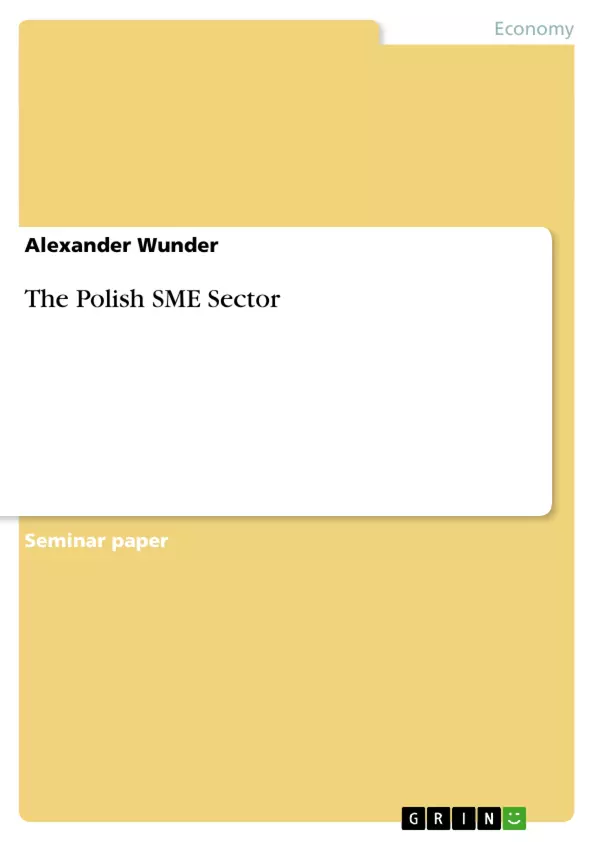In the following paper I want to pay attention to the SME (Small and Medium-sized Enterprises) Sector in Poland. Researches within this Sector are very important, because that sector is the most dynamic in the whole Economy. Entry and Exit Rates of Businesses are about 10 % in the EU (European Union) and are even more in Poland. Noreen Doyle described it as the backbone for a lasting and effective business environment. As well as in the Transitional Period, which will be examined in detail in this paper, as in the accession phase of Poland to become member of EU, the development of the SME Sector will determine the future of Poland to a great extent. After defining this Sector, I will show the development separated in phases since 1980. In the following chapter, I will try to sum up the most important influencing factors for SMEs. Finally, I will consider some specific problems of Poland joining the EU.
Inhaltsverzeichnis (Table of Contents)
- Introduction
- 1. Definition and quantitative statistics
- 1.1 Europe
- 1.2 Poland
- 2. Development of SMEs in 4 Stages
- 2.1 Pre-transformation Phase (1980-1988)
- 2.2 Phase of Entrepreneurship Explosion (1989-1991)
- 2.3 Phase of Stabilisation (1992-1994)
- 2.4 Pre-accession Phase, Transition Period (1995-2004)
- 3. Polish SMEs in Single European Market
- 3.1 Analytic model
- 3.2 Levels of Influence
- 3.2.1 Macro-economic level
- 3.2.2 Mezo-economic level
- 3.2.3 Micro-economic level
- 3.3 Results of Analysis
- 3.4 Problems of polish SMEs in a single European market
- 3.4.1 Weak starting position
- 3.4.2 Domination of large companies
- 3.4.3 Full membership
- 3.4.4 Hidden economy
- Final Comment
Zielsetzung und Themenschwerpunkte (Objectives and Key Themes)
This paper delves into the Polish SME (Small and Medium-sized Enterprises) sector, highlighting its significance as the most dynamic component of the Polish economy. It examines the development of the SME sector in Poland from 1980 to 2004, analyzing the key factors influencing its growth and identifying the specific challenges faced by Polish SMEs in the context of the Single European Market.
- The importance and role of the SME sector in the Polish economy.
- The development of the SME sector in Poland through various phases.
- The impact of key factors influencing the growth of SMEs.
- The specific problems faced by Polish SMEs in the European market.
- The future of the SME sector in Poland in the context of EU membership.
Zusammenfassung der Kapitel (Chapter Summaries)
The first chapter defines the SME sector and provides quantitative statistics on the sector in both Europe and Poland. It examines various definitions of SMEs and highlights the importance of the European Commission's 1996 definition for ensuring comparability across EU member states. The chapter also presents data on the number of active enterprises, employment, and revenue contributions of private SMEs in Poland.
The second chapter explores the development of the Polish SME sector in four stages: pre-transformation, entrepreneurship explosion, stabilization, and pre-accession. It outlines the key characteristics and challenges of each phase, providing an overview of the historical context of SME development in Poland.
The third chapter examines the impact of Poland's participation in the Single European Market on the SME sector. It analyzes the influence of macroeconomic, meso-economic, and micro-economic factors on Polish SMEs and presents the results of an analysis of the sector's performance. Additionally, it delves into the specific problems encountered by Polish SMEs within the European market, such as weak starting positions, the dominance of large companies, and the challenge of the hidden economy.
Schlüsselwörter (Keywords)
The main keywords and focus topics of this paper include the Polish SME sector, economic development, transition period, European integration, single European market, EU membership, macroeconomic factors, meso-economic factors, micro-economic factors, and the challenges of SME growth in a competitive market environment.
- Quote paper
- Alexander Wunder (Author), 2003, The Polish SME Sector, Munich, GRIN Verlag, https://www.grin.com/document/29370



